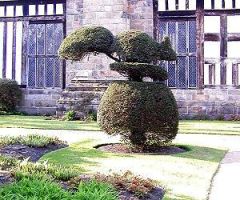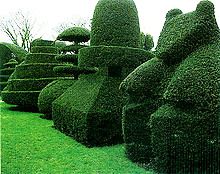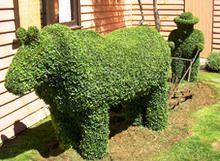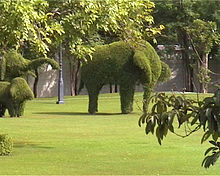The art of trimming pruning and shaping

Gardens in different locations have different shapes and styles, for instance if you happen to have visited Mughal Gardens at Rastrapati Bhawan, you would witness Mimusops Elengi an evergreen medium sized plant better known as Maulsari, Moulsree, Bokul lei, Bakuli, Ranjan, Barkoli, Omval, Kirakuli, etc Spanish Cherry etc. They have developed a portion of Mughal gardens as Topiary art section by clipping, trimming and giving these trees shapes of elephants, peacocks, herds of deer, giraffe etc. The main gate of this section has two big elephants shaped sculptured of Clerondendron (common names Bag flower, bleeding heart etc) trees, their trunks locked with each other.
Hanging Gardens of Mumbai is another good example of Topiary art where we have some wonderfully attractive designs of peacock, rhino, dear, tiger, lion, rabbit and birds etc. A scripture of farmer with his bull is one of the most attractive one especially over the long trail of green hedging.
Your garden with a unique look

Art of cutting, pruning and shaping the Topiary gives an extra ordinary look to your garden; the visitor to your house would find it amazing with beautifully designed animal or other designs of your choice. There are many other world famous Topiary gardens are spread allover the globe but these are taking their place in private owned gardens now and that make these gardens different from other traditional gardens. Let me add here that Topiary is basically favorite gardening art of Romans and Japanese who came up with geometrical designs like cones, cubes and pyramids etc trimming trees. Later artists changed to animals and other living creatures for Topiary art.
You must be careful while planting for Topiary designs because the plants needed for such designs should be slow growing, multiple branches, long living, evergreen, with small leaves and these plants should not catch diseases easily. You should support the weak stemmed plants or vines to grow according to your desired direction by using bamboo, wooden or iron made supports. You can even tie them up with ropes to grow in a particular direction. You can plant shrubs like Clerodendrum inerme, Inga dulcis, Duranta, Plumaria, Murraya exotica (Kamini) etc to for the purpose of Topiary designs.
Here are some of the plants suggested for your various designs

1- For Birds- You should select from Poncirus trifoliata or Casuarina she-oak specie-type plants.
2- For umbrella designs - you should look for a plant like Citrus madurensis, Citrus aurantium or a plant like Maulsari mentioned in the beginning of this article. I have seen such plants designed as umbrella in Mughal gardens.
3- For round designed shapes - Thuja orientalis, Thuja compacta should be used for best results.
4- For pillar designs - Polyalthia longifolia, Polyalthia pendula serves your purpose best
5- For writing or edge making - You can plant Aerva sanguinolenta or Poncirus trifoliata for this purpose.
How to plan your Topiary formation
Although this is job of an expert but if you want to try your hands on Topiary, you should prepare a structure for the design you are planning to make. To make a basic structure you can use soft steel, galvanized wire or bamboo according to size of your proposed design. The basic structure should match exactly as per your planned sculpture.
* You should begin your planting in the month of February-March or July-August for the purpose of making a Topiary sculpture choosing carefully the plants, shrubs etc for your required design. You must also keep cutting, trimming or pinching regularly to give your plants proper shape. You should fix the structure in the beginning and plant accordingly, if your sculpture’s size is big. You can fix the structure later while you find that your plants are big enough in case your proposed design is not too big.
* If you are planning to design an animal for Topiary, you should fix the basic structure and plant four different plants for legs and tie them with structure with the help of ropes. Cut and trim them accordingly to bring these plants to shape. Please be very careful about management of weak branches because these could ruin the whole sculpture before you would know. It is better to grow a parallel plant and shape it accordingly.
* Topiary needs special care for water and fertilizers so that its growth remains healthy. You should take extra care to use proper chemicals to keep these plants away from insects and diseases those may harm these plants. It is better to use natural garden pest control methods, which are far cheaper than pesticides. Use of helpful chemicals help grow plants good and fast and keeps them green forever. Be very careful while tackling insects, which are main enemies of such sculptures. You should also take proper care of debris disposal from your garden because most harmful insects take place right there.

Finally
You can also use Topiary art to give your garden a unique view by learning its finer points. The art of trimming, pruning and cutting needs lot of efforts and labor but if you have time and willingness, you can do wonders. Please remember that pruning and trimming are not only good for keeping you plants in shape but help keep them healthy and live longer as well.
Please note – I have used mostly botanical names of plants and shrubs as the names in use in different areas may create confusion.
Pictures used are from wikipedia.